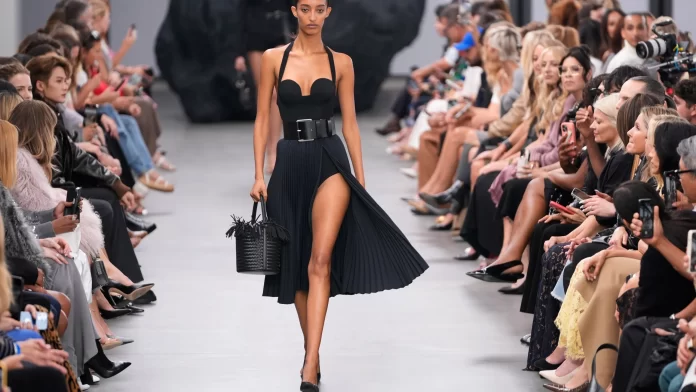New York Fashion Week (NYFW) — the throbbing nucleus of the American fashion industry — has always commanded the tale of cultural seismic shifts and primary launchpad for new trends. With NYFW 2025 coming into our sights, we feel it coming. When put to the test, the naturally developing industry is ready to present a future where technological innovation is seamless, intertwining with great dedication to sustainability, putting style and consumption beyond recognition.
A Technological Renaissance on the Runway:
While NYFW 2025 will include the display of garments, it will be so much more — an immersive, interactive experience. Putting augmented and actual reality (AR) and virtual reality (VR) into divergence is going to move beyond ordinary runway directions, enabling the world extensively from here to participate in various sensation form functions. Think of AR headset users gazing at digitally placed garments spanning over real models or going on virtual catwalks through unreal, real scapes.
- Phygital Fashion: The pinnacle of “phygital” – blending physical and digital experiences – will come to the past. Through interactive mirrors and mobile apps, designers will supply virtual try-ons with the ability to see garments on one’s own avatars before purchasing. Not only will shopping be improved, but returns and waste will be greatly diminished.
- AI-Powered Personalization: One primary beneficiary of this is artificial intelligence (AI). Personalized recommendations and even custom-designed garments would be generated by AI algorithms based on data on consumer style preferences, body measurements, and lifestyle choices. Picture what would happen if your clothing was not just a representation of your style but an expression of precisely what your body requires at that specific moment.
- Introducing Interactive Textiles and Wearable Technology: The line between fashion and technology will further blur with the introduction of interactive textiles and wearable technology. Sensors in the garments will mold to the wearer’s environment, changing the color or pattern depending on the temperature or mood. The sum of smart fabrics will monitor health metrics and give real-time feedback to create personal wellness companions for the clothing.
- 3D-Printed Couture: 3D printing will persistently change the way fashion is fashioned, allowing one-of-a-kind unstable parts to be made in one-of-a-kind exquisite particulars. In turn, this technology will enable consumers to personalize and customize their clothing and grow a feeling of co-creation.
- Fashion Expression Stage: The Metaverse is going to be the main stage for the self-expression of fashion. Virtual collections will be designed for digital avatars for the growing demand for digital fashion by designers. People in these countries will watch virtual fashion shows, allowing the physical world and the virtual world to merge into one.
Sustainability at the Forefront: A Conscious Approach to Fashion:
The purpose of NYFW 2025 is to provide a powerful stage to help the fashion industry to promote sustainable practices. Designers will be forced to implement eco-friendly materials and production methods as the need for addressing environmental concerns is urgent and immediate.
- The Principles of Circular Fashion: There will be a total embracement to the principles of circular fashion – reduce the waste, reuse the materials, and recycle the garments. Mediocre clothing from upcycled textiles will be presented, and discarded fabrics will become high fashion clothing.
- Bio-Based Materials and Sustainable Alternatives: Building towards The search for sustainable alternatives to traditional textiles will continue. Natural source-based innovative materials such as algae, mushrooms, and even food waste will be the topic. This will provide a reduced environmental footprint and different appearance through these bio-based materials.
- Ethical Sourcing and Transparent Supply Chains: Consumers will expect greater transparency in the production process and expect brands on the other end to treat the sourcing process with more ethics and fair labor practices. Tracing garments from raw materials and assembly in one single brand to customers and back should be possible using blockchain technology, which will ensure traceability and accountability.
- Fast Fashion to Slow Fashion: The primary focus will be on how to shift away from fast fashion toward mindful consumption and designs that endure. This will encourage consumers to invest in quality pieces that last, and this will reduce the number of companies that keep producing items that aren’t quality.
- Rental and Resale Platforms: Rental and resale platforms will expand with this and help consumers access many different styles with no ownership needed. Such platforms will help extend the life of garments and reduce textile waste.
- Carbon Neutral Fashion Shows: The goal is to minimize the environmental impact and stick to carbon-neutral practices. Included will be using renewable energy sources, level of carbon emissions, and reduction of waste generation.
The Evolving Role of the Designer and the Consumer:
At NYFW 2025, there will be a huge change in the roles of designers and consumers. Everyone will design, and everyone will become an innovator, technologist, and sustainability advocate. Today, technology arms the consumers, who, in turn, act ethically to become active participants in the fashion ecosystem.
- Technologist as Designer: Designers will have to know Holistically well about AR VR AI, and 3D printing. Together, they will work with engineers and programmers to build wonderful designs and immersive experiences.
- Promoting Sustainability through Fashion: Designers will function as advocates for sustainability through fashion, promoting it and educating audience consumers about the environmental damage that fashion takes. They will also become an advocate of using eco-friendly materials, recycled materials such as polyester sewing thread, polyester embroidery thread, etc, and ethical production methods.
- Co-Creator: Consumers are going to be able to customise and personalize their clothes and thus become the designer. This will initiate ownership and a connection to the clothes.
- Consumer as Socially Responsible Citizen: Consumers will view their purchasing choices as an opportunity to counter environmental and social effects. Brands will demand transparency and accountability, they will support brands that care about sustainability and ethical practices.
As digital fashion continues to rise, the role of the digital stylist will play so much in importance. For instance, these stylists will curate virtual wardrobes, create digital looks and help consumers pick digital fashion.
The Future of Fashion: A Collaborative and Inclusive Ecosystem:
The fashion industry will present itself for the collaborative and open-mindedness of NYFW 2025. A future in which designers, technologists, sustainability experts, students, professionals, and consumers all create, generate, and build the future in fashion.
- Collaboration: Fashion brands will collaborate with technology companies, and this will lead to innovation and bring about new possibilities.
- Crowdsourcing of Creativity: The open source design platforms will enable design to be shared within the designer community and through the community with the free flow of ideas and the crowdsourcing of creativity.
- Decentralized Fashion Platforms: Blockchain technology will enable the creation of decentralized fashion platforms, which will empower independent designers and bring more transparency as well as a fairer and more balanced industry.
- Democratization of Fashion: Digital technologies will make fashion accessible to audiences globally and allow them to participate in NYFW and witness the newest trends.
- Inclusivity and Diversity: Formulating NYFW 2025 will bring inclusivity and diversity through a variety of styles and perspectives. The aim of the industry is to make the fashion landscape more equitable and representative.
NYFW 2025 will not be just a display of new seasons, it will be an impetus of new fashion. This will be an innovation of technology, sustainability, and human creativity, going towards an industry in a more innovative, conscious, and inclusive future. The goes on will draw people, the story behind them will be progress and watching for the future.
Conclusion
Overall, New York Fashion Week 2025 promises to be a major turning point for the industry as it breaks out of its usual confines. How technology and sustainability can join forces to transcend the very meaning of fashion will be a powerful demonstration. AR/VR, AI, and 3D printing will form immersive experiences and personalized designs, this will be paired with a deep commitment to circular fashion, bio-based materials, and ethical practices to create a more sustainable future.
There will also be a major deviation in the roles of designers and consumers as part of this event. Consumers will participate in the fashion ecosystem by being active in demand of transparency and co-creation of style, and the designers will evolve into technologists and sustainability advocates. This allows for a more inclusive and democratic industry with the collaboration of technologists and sustainability experts, leaving global audiences to the dialogue.
While NYFW 2025 will not only be about displaying a fleeting trend, it will also light the path to a future where fashion looks impressively aesthetically pleasing but also technologically advanced, environmentally conscious, and socially responsible. That could be a sign of the ability of the industry to adapt, to innovate, and to accept a more sustainable and just future, and that style and substance can be one without the other. Nothing can be the same after this event, the direction of fashion for the years to come, the solidification of New York as a global leader in the constantly changing world of style.




